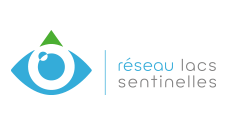Protocols
The joint monitoring protocol for high-altitude lakes takes into account the difficulties involved in site access, the field officers' limited time, and the need to reduce costs as much as possible. It is therefore based on:
- an annual on-site campaign,
- optimised sample material,
- flexible return time for samples
- low analysis costs for samples taken.
The samples and measurements are taken from a point in line with the deepest part of the lake, identified by GPS, and marked by a permanent chain of thermistors (high-frequency temperature sensors).
These on-site missions take place in September (at the end of the stratification period and the peak of primary production) and involve at least three people as the equipment (including the boat, paddle, rope, probe, etc.) has to be carried in most situations.
The stakeholders working in the Observatory must respect a charter for the implementation of monitoring protocols in order to ensure homogeneity in the data collected.
As a long-term monitoring programme, network discussions help to regularly evaluate the relevance of the measurements carried out and, potentially, to make changes in the joint protocol depending on the knowledge gained and defined needs.
The joint protocol proposes the implementation of permanent temperature sensors, multiparameter probe profiles and, for some lakes, limited sampling of the body of water (plankton and fish). The parameters can be classified according to two categories:
- "Mandatory" parameters
- "Optional" parameters
Mandatory parameters
At least three parameters are carried out on each of the Observatory's lakes:
- water transparency,
- development of a multiparameter probe profile (pH, temperature, conductivity and dissolved oxygen) across the entirety of the water column,
- temperature readings from thermistors (data-loggers), placed at the bottom of the lake and beneath the surface of the water, along a fixed, submerged chain.
These parameters, which are easy to implement and do not require a lot of equipment, provide information about:
- the annual transparency of the lake and its physico-chemical state,
- continuous temperature changes in the column of water.




Optional parameters
For some lakes, complementary samples and measurements are carried out in order to study other compartments of the ecosystem (chemical analysis, phytoplankton, zooplankton, chlorophyll a, fish, etc.) in a more precise way.
Today, these monitoring parameters are optional because they require more time to implement and a recurring cost for analysing the samples.
 Téléchargez le tableau des protocoles mis en oeuvre sur les lacs de l'observatoire
Téléchargez le tableau des protocoles mis en oeuvre sur les lacs de l'observatoire

 La présence de poissons dans les lacs d’altitude, est liée, dans la majorité des cas, à des interventions humaines.
La présence de poissons dans les lacs d’altitude, est liée, dans la majorité des cas, à des interventions humaines.
 L’analyse de la chlorophylle a permet d'estimer la biomasse d’algues qui se retrouve dans le prélèvement d'eau. Il est ainsi possible de connaître la productivité du lac à un moment précis dans le temps. La comparaison des données de chlorophylle a au fil des années permet de déterminer si la productivité du lac est stable.
L’analyse de la chlorophylle a permet d'estimer la biomasse d’algues qui se retrouve dans le prélèvement d'eau. Il est ainsi possible de connaître la productivité du lac à un moment précis dans le temps. La comparaison des données de chlorophylle a au fil des années permet de déterminer si la productivité du lac est stable.
 Le zooplancton est un plancton animal qui se nourrit de matière vivante, certaines espèces étant herbivores et d’autres carnivores.
Le zooplancton est un plancton animal qui se nourrit de matière vivante, certaines espèces étant herbivores et d’autres carnivores.
 Le phytoplancton, qui regroupe toutes les espèces d’organismes photosynthétiques de moins d’1 mm en suspension dans l’eau, se trouve à la base des chaînes alimentaires aquatiques.
Le phytoplancton, qui regroupe toutes les espèces d’organismes photosynthétiques de moins d’1 mm en suspension dans l’eau, se trouve à la base des chaînes alimentaires aquatiques.
 Les concentrations de nombreuses espèces chimiques changent au sein d’un milieu lacustre, principalement du fait de l’activité biologique qui s’y déroule. C’est elle qui contrôle directement ou indirectement l’ensemble des réactions chimiques qui se produisent et qui conduisent à des environnements chimiques différents. A ces processus chimiques « naturels » s’ajoutent également les composés « synthétiques » (micro-polluants).
Les concentrations de nombreuses espèces chimiques changent au sein d’un milieu lacustre, principalement du fait de l’activité biologique qui s’y déroule. C’est elle qui contrôle directement ou indirectement l’ensemble des réactions chimiques qui se produisent et qui conduisent à des environnements chimiques différents. A ces processus chimiques « naturels » s’ajoutent également les composés « synthétiques » (micro-polluants).

Différents capteurs sont installés dans les lacs suivis par le réseau Lacs Sentinelles. Ces capteurs permettent d'obtenir des données haute fréquence, c'est-à-dire des données en continue tout au long de l'année. Dans chaque lac, des capteurs de température sont installés à différentes profondeurs et permettent d'assurer un suivi de la thermie du lac. Certains lacs sont également équipés d'un capteur d'oxygène au fond du lac, de capteurs de luminosité et de pression.

 L’oxygène dissous présent dans les lacs est utile à la respiration des organismes aquatiques. Cependant, ce phénomène n’est efficace que si l’oxygène est présent au-delà d’une certaine concentration, car les organismes aquatiques ont besoin d’une quantité minimale d’oxygène dissous pour survivre.
L’oxygène dissous présent dans les lacs est utile à la respiration des organismes aquatiques. Cependant, ce phénomène n’est efficace que si l’oxygène est présent au-delà d’une certaine concentration, car les organismes aquatiques ont besoin d’une quantité minimale d’oxygène dissous pour survivre.
 Le potentiel Hydrogène renseigne sur le degré d’acidité des lacs.
Le potentiel Hydrogène renseigne sur le degré d’acidité des lacs.
 Paramètre essentiel de la productivité d’un lac d’altitude, la conductivité est le reflet de la minéralisation de l’eau.
Paramètre essentiel de la productivité d’un lac d’altitude, la conductivité est le reflet de la minéralisation de l’eau.
Les diatomées benthiques sont des algues constituées d'une unique cellule, donc de taille microscopique, vivant dans l'eau soit en suspension (diatomées pélagiques) soit sur le fond (diatomées benthiques). Les diatomées sont utilisées comme indicateur de la qualité des eaux douces continentales.
 Relevée sur la colonne d’eau maximale, la profondeur de Secchi est une mesure simple et rapide pour déterminer la profondeur de la zone euphotique (profondeur d’eau exposée à une lumière suffisante pour que la photosynthèse se produise).
Relevée sur la colonne d’eau maximale, la profondeur de Secchi est une mesure simple et rapide pour déterminer la profondeur de la zone euphotique (profondeur d’eau exposée à une lumière suffisante pour que la photosynthèse se produise).


![]() Téléchargez le tableau des protocoles mis en oeuvre sur les lacs de l'observatoire
Téléchargez le tableau des protocoles mis en oeuvre sur les lacs de l'observatoire

 La présence de poissons dans les lacs d’altitude, est liée, dans la majorité des cas, à des interventions humaines.
La présence de poissons dans les lacs d’altitude, est liée, dans la majorité des cas, à des interventions humaines. L’analyse de la chlorophylle a permet d'estimer la biomasse d’algues qui se retrouve dans le prélèvement d'eau. Il est ainsi possible de connaître la productivité du lac à un moment précis dans le temps. La comparaison des données de chlorophylle a au fil des années permet de déterminer si la productivité du lac est stable.
L’analyse de la chlorophylle a permet d'estimer la biomasse d’algues qui se retrouve dans le prélèvement d'eau. Il est ainsi possible de connaître la productivité du lac à un moment précis dans le temps. La comparaison des données de chlorophylle a au fil des années permet de déterminer si la productivité du lac est stable. Le zooplancton est un plancton animal qui se nourrit de matière vivante, certaines espèces étant herbivores et d’autres carnivores.
Le zooplancton est un plancton animal qui se nourrit de matière vivante, certaines espèces étant herbivores et d’autres carnivores. Le phytoplancton, qui regroupe toutes les espèces d’organismes photosynthétiques de moins d’1 mm en suspension dans l’eau, se trouve à la base des chaînes alimentaires aquatiques.
Le phytoplancton, qui regroupe toutes les espèces d’organismes photosynthétiques de moins d’1 mm en suspension dans l’eau, se trouve à la base des chaînes alimentaires aquatiques. Les concentrations de nombreuses espèces chimiques changent au sein d’un milieu lacustre, principalement du fait de l’activité biologique qui s’y déroule. C’est elle qui contrôle directement ou indirectement l’ensemble des réactions chimiques qui se produisent et qui conduisent à des environnements chimiques différents. A ces processus chimiques « naturels » s’ajoutent également les composés « synthétiques » (micro-polluants).
Les concentrations de nombreuses espèces chimiques changent au sein d’un milieu lacustre, principalement du fait de l’activité biologique qui s’y déroule. C’est elle qui contrôle directement ou indirectement l’ensemble des réactions chimiques qui se produisent et qui conduisent à des environnements chimiques différents. A ces processus chimiques « naturels » s’ajoutent également les composés « synthétiques » (micro-polluants).

 Relevée sur la colonne d’eau maximale, la profondeur de Secchi est une mesure simple et rapide pour déterminer la profondeur de la zone euphotique (profondeur d’eau exposée à une lumière suffisante pour que la photosynthèse se produise).
Relevée sur la colonne d’eau maximale, la profondeur de Secchi est une mesure simple et rapide pour déterminer la profondeur de la zone euphotique (profondeur d’eau exposée à une lumière suffisante pour que la photosynthèse se produise).